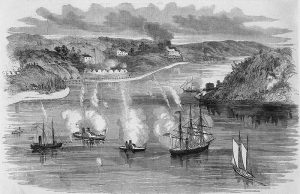From the beginning of the Civil War, Chesapeake Bay was one of America’s most important water bodies. The capitals of both the Confederacy and the United States sat next to Bay rivers: Richmond, Virginia, is on the James River, and Washington, D.C., is on the Potomac River. Because of its close distance to both capitals, the Bay and its rivers played an important role in many Civil War battles. Huge armies prowled around Maryland and Virginia throughout the entire war. Access to the Bay meant the ability to receive shipped goods, quickly transport troops from one point to another, and threaten the enemy with strikes deep into their territory. President Abraham Lincoln proclaimed the blockade in April 1861, and the first campaign occurred in May and June 1861.
Sewell’s Point (May 18-19, 1861) – Occurring near Norfolk City, two Federal gunboats, the USS Monticello and the USS Thomas Freeborn, exchanged cannon fire with Confederate batteries on Sewell’s Point. The Union attack supported a blockade of the southeastern Virginia ports at the southern end of the Chesapeake Bay. It had previously captured several ships that attempted to pass the blockade. USS Monticello’s bombardment of the Sewell’s Point battery was one of the earliest Union Navy actions against Confederate forces during the Civil War. The result of the battle was inconclusive, but it ended in an estimated 10 casualties.
Aquia Creek (May 29-June 1, 1861) – Taking place in Stafford County, three Union naval vessels under the leadership of Commander James H. Ward bombarded Confederate batteries near Aquia Creek’s mouth. These batteries were built to protect the northern terminus of the railroad to Richmond. Confederates feared a landing of troops, but this did not materialize. Results of the bombardment were inconclusive, but the battle resulted in 10 estimated casualties.
Big Bethel (June 10, 1861) – Also known as the Battle of Bethel Church or Great Bethel, this was one of the earliest land battles Civil War. On June 10, 1861, Major General Benjamin F. Butler sent converging columns from Hampton and Newport News against advanced Confederate outposts at Little and Big Bethel. Confederates abandoned Little Bethel and fell back to Brick Kiln Creek’s entrenchments near Big Bethel Church. Under the immediate command of Brigadier General Ebenezer Pierce, the Federals pursued, attacked frontally along the road, and were repulsed. Crossing downstream, the 5th New York Zouaves attempted to turn the Confederate left flank but were repulsed. Unit commander Colonel T. Winthrop was killed. The Union forces were disorganized and retired, returning to Hampton and Newport News. The battle engaged about 3,500 Union soldiers and 1,200 Confederates. Though the southerners were outnumbered, the battle resulted in a Confederate victory. There were an estimated 79 Union casualties, compared to 8 Confederate.
While minor in comparison to the many larger, bloodier, and more significant battles later in the war, the Battle of Big Bethel and all early Civil War military engagements attracted considerable notice, press coverage, and exaggerated importance because of the newness of the war and the general feeling the war would be short.
Compiled and edited by Kathy Weiser-Alexander/Legends of America, updated October 2021.
Also See:
Sources:
Battlefields.org
National Park Service Battle Descriptions (no longer available online)
National Park Service Civil War


